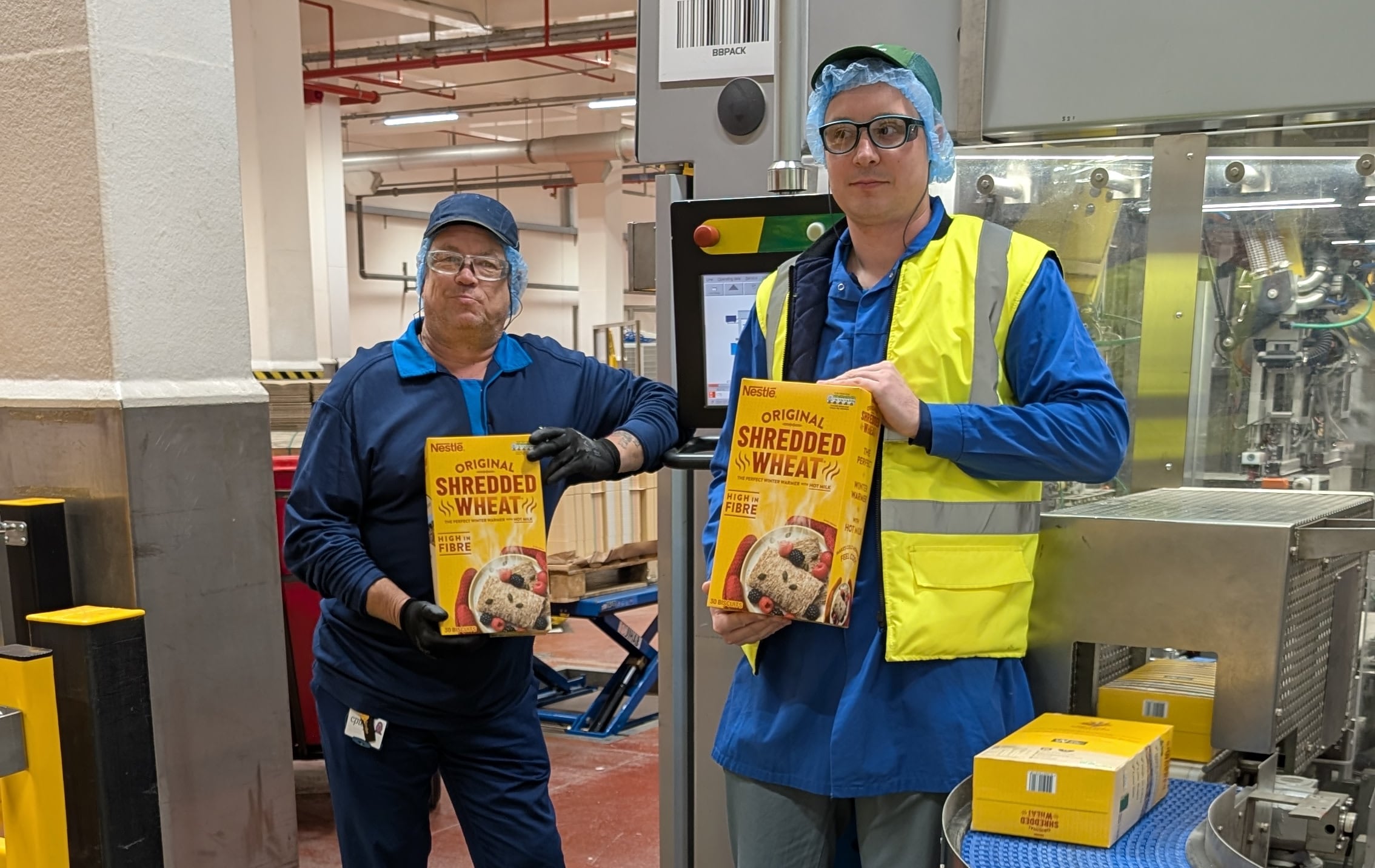Company address: Cereal Partners, Staverton, Trowbridge, BA14 6PG
Number of employees: Around 200
Size of site: Two acres of operational farmland surrounded by 14 acres of woodland
Shift patterns: Three shifts a day or four on/four off week
Types of lines: Produces Shredded Wheat, Shredded Wheat Bite Sized and Shreddies.
Output: 21,000 tonnes split between Shredded Wheat, Shredded Wheat Bite Sized and Shreddies.
While Cereal Partners has called Staverton home since 1998, the site can trace its roots as far back as the 14th century. Not yet known for food, the site in which the factory now stands used to be a woollen mill that served the area until the end of the 19th century.
In 1897, the site was sold to the Anglo-Swiss Condensed Milk Co. to facilitate expansion of their condensed milk production. The company merged with Farine Lactée Henri Nestlé in 1905 to become the Nestlé that we know today.
In fact, the manufacturer’s presence is so strong within the local community that even when Cereal Partners – the joint venture between Nestlé and General Mills – took over the Staverton site, most people in the area still refer to it as the Nestlé factory.
Justin Hill started his career with Nestlé in 1998 as a manufacturing technician, progressing his way through the businesses to where he now sits as systems performance manager for the Staverton site.
“Typically, every four to five years I’ve had a career change within the factory – team leader, to continuous system performance manager – all different roles I’ve had the opportunity to do,” he explains. “I’ve always had the opportunity to do something different.”
He describes the Staverton site as a ‘lighthouse’ factory inside of the business, serving as a beacon of inspiration for other Nestlé and Cereal Partners sites.
Lighthouse facility
Like many food and drink factories, there are plenty of ways in which performance is measured. This could be anything from how well the factory performs, or how you’ve managed to reduce unplanned stops, to the implementation of AI technology.
When a factory makes a massive change to one of these measures, the rest of the business takes notice and will go out of the way to understand just what it is they’ve done and how the same practice can be replicated across other factories.
As Hill describes it, Cereal Partners Staverton has become a lighthouse facility, a factory in which so many innovations have been made that other sites will come to visit so that they can be guided towards ways to operate better.
“They’d then go away with those learnings and implement some of the stuff that we may have done in the factory,” Hill added.
“That sort of thing is what being a lighthouse is all about – being a beacon guides the rest of the business.”
Any factory can be a lighthouse for something specific, but rarely can it be one for everything – as good as that would be.
“We’re one of the best factories to use DMOS [digital manufacturing operating systems] so people are learning how we use that,” said Hill.
“We’ve also been selected to do performance development review.
“So, we’ve been recognised for some of the good stuff we’ve done around how we develop and evolve people.”
Local community
The local community has been at the heart of the Staverton site and is one of the largest employers in the local area – as Charlotte Ward, the site’s systems engineer, explains, most of the employees live within a 10-mile radius of the factory.
With so many people living locally, it makes sense that any charity initiatives or support programmes the site chooses to invest in feed back into the community that runs it.
“We tend to support the employees – if they’ve got children that play football, we’ve sponsored local football teams, that sort of thing,” Ward added.
“We have a donation committee that has a pot that we can share out to any of our employees who request donation money if it’s for a good cause – charity events, that sort of thing.
“We’re in a position to help people and it’s the responsible thing to do – if you can, you should, because we do have a lot of resources here that can help other people. On a selfish note, I really enjoy doing it, it makes me feel good.”
What’s more, the support that Cereal Partners Staverton provides to the local community serves as great PR for the wider business – especially a business that provides itself on its commitment to people.
“It’s nice to feel you can give back to the people,” said Hill.
“I wouldn’t say we’re privileged, but we’re quite lucky where we work, so if you’re in a position to give back, you should.”
Outside of its direct work with local projects, Staverton also donates its food waste through surplus redistribution charity Fareshare. The manufacturer donated three tonnes of cereal last year, which made its way to 158 charities across the south west of England – roughly 72,500 servings of cereal.
“On a food waste point of view, sometimes we have to collect cases on the line for sampling and there’s nothing wrong with the product and we don’t want to throw it away. So that’s a sustainability point of view, to be able to donate that,” Ward continued.
As a mainstay within the local area for more than 100 years, the Staverton site has seen its fair share of investments. In March, the manufacturer announced it was to spend £74 million in expanding the capabilities of the Staverton site in a bid to better adjust Cereal Partner’s manufacturing footprint in the UK and Ireland.
At the time of visiting the site, Staverton’s most recent investment was in upgrading the floors and lights, but Hill assures there is always investments being made into the factory.
“We’ve upgraded all the lights to LEDs to make it much brighter and we’ve resurfaced all of the floors to light grey – it highlights the ‘bit in the middle’, our clean, inspect and lubricate standards,” he added.
“We’ve got some new baggers coming next month, we’ve had all new case packers at £1 million apiece. There’s always investment going on somewhere.”
Other recent investments have seen the business fund better flood defences for the factory, a tell-tale sign of the impact that climate change can have on manufacturing sites. Hill noted that the site recently saw the highest rainfall since he joined the company 27 years ago.
“Then there’s the whole environmental piece around finite resources,” he said.
“We are a large factory and we use a lot of energy, a lot of gas. We need to use those finite resources in the right way and not waste them.
“When we talk about the efficiency of an area of the factory, there’s the cost but there’s also the environmental benefit. So it’s about trying to think smarter.”
Next Steps
As for the future of Cereal Partners, Hill said it all lies in new product development.
“We’ve got the staples – big biscuit Shredded Wheat, small biscuit bite sized Shredded Wheat and Shreddies – but there’s opportunities, I think, to do some more development on different flavours and tastes,” Hill continued.
“Obviously financially, if you go into Lidl or Aldi, Nestlé Shreddies, on average, are £3 a box and you’ve got the own-brand at £1.15. In the current credit crunch, everybody’s going for the cheap own-brand as opposed to the branded stuff, so it’s a challenge for the business to make the taste difference worth the more money you’re paying for them.”
Ward calls it the 60/40 superiority – 60% of consumers who buy branded cereal compared to 40% who buy own-brand.
“It’s difficult when they’re so close in taste, especially when it’s Shredded Wheat where there’s only one ingredient,” she said.
“It’s difficult when everyone is cutting back on everything, so that’s the major thing we’re focused on for this year and next.”




